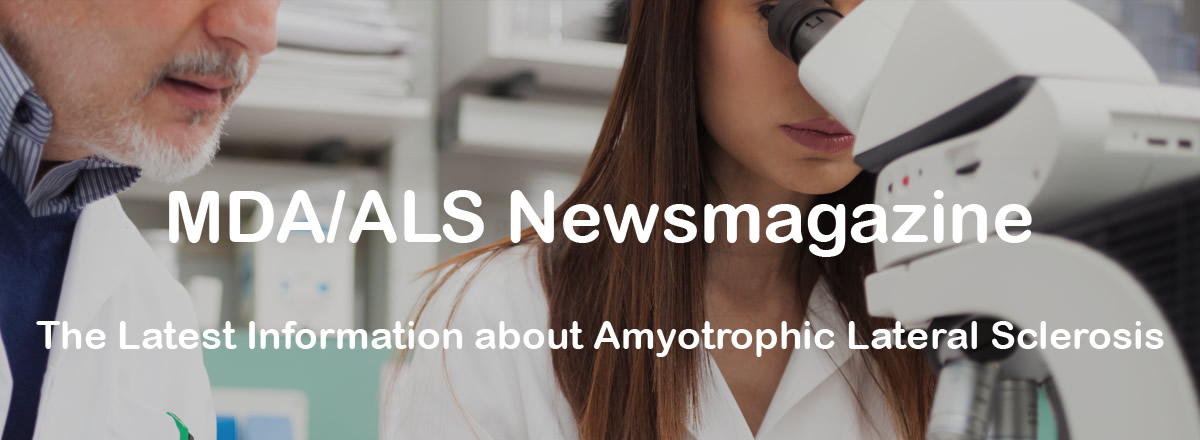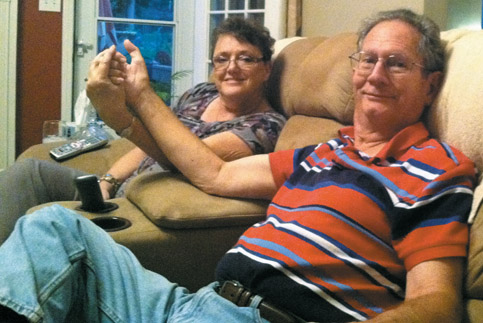
When the Thinking Parts of the Brain Go Awry in ALS

John Shearer and his wife Brenda learned in November 2010 that he has ALS. The couple, who lives in Woodstock, Ga., were told the disease would cause gradual weakening of John’s voluntary muscles, such as those used for moving and breathing.
John, 70, retired four months later in March 2011 from Lockheed Martin Aeronautics, where he worked 41 years as a machinist.
As predicted, over the past year the muscles in John’s legs and hands have weakened, and he now needs noninvasive ventilation at night to help him breathe.
But that’s not all. Although John is still able to talk, Brenda says, he “doesn’t carry on conversations anymore.”
This behavior change is due not to muscle weakness, but to John’s difficulty in processing words, focusing and paying attention, following what’s being said, and formulating an appropriate response, Brenda says. She likens his symptoms to a computer with a faulty processor that, when it works, does so with a slow modem.
“When I ask John something, it’s like it just doesn’t register,” she says. “And sometimes he never answers.”

Cognitive changes in ALS
Traditionally, ALS has been described as a neurodegenerative disease affecting the motor neurons that control muscles. Involvement of other “non-motor” systems was thought to be rare.
But cognitive and associated behavioral symptoms associated with ALS have been noted in studies dating as far back as 1889. Today, it is known that approximately 50 percent of the time, ALS is accompanied by some degree of frontotemporal lobar degeneration (FTLD), a type of progressive deterioration in the frontal and temporal lobes of the brain (situated in the area of the forehead and extending approximately as far back as the ears).
ALS is now known to be a multisystem disorder. Loss of motor neurons still is the hallmark of the disease, but non-motor involvement, including degeneration in parts of the brain responsible for cognitive function, also is recognized.
Although roughly half of all people with ALS exhibit at least some symptoms of cognitive impairment at some stage of their disease, only a small percentage are like John Shearer, whose severe cognitive and behavioral difficulties meet the criteria for an official diagnosis of frontotemporal dementia (FTD).
Usually, cognitive and behavioral symptoms in ALS range from mild (such that only close family members may notice a difference) to moderate. Symptoms include atypical behaviors, apathy and poor judgment, anger and irritability.
The simultaneous occurrence of both disorders is called ALS-FTD.
An overlap between ALS and FTD
These two distinct disorders — FTD and ALS — are merging, and scientists are coming to understand that there’s tremendous overlap between the two, says Stanley H. Appel, chairman of the Department of Neurology at the Methodist Neurological Institute, in Houston, and director of the MDA/ALS clinic there. (For more, view the video below of Appel discussing cognitive changes in ALS.)
Scientists have identified several genes that appear to be associated with both ALS and FTD. This fall, researchers uncovered a gene, C9ORF72, which they identified as the most common cause to date of familial ALS, FTD and ALS-FTD.
In addition, a 2005 study found FTD-associated changes in the brains of all ALS participants, whether or not they showed signs of cognitive impairment.
“We did a study in ALS patients who were cognitively normal, and they had changes in the frontal and temporal regions of the brain consistent with FTD,” says Catherine Lomen-Hoerth, who directs the MDA Clinic at the University of California at San Francisco (UCSF) Medical Center. “It’s just to a much lesser degree, so there are no obvious symptoms.”
Symptoms of FTD in ALS
The term “FTD” in ALS can be confusing. This is because physicians and researchers often use it in a general way to refer to the entire spectrum of cognitive and behavioral problems that may occur, from barely noticeable “mild cognitive impairment” to disturbances of a more profound nature that satisfy the criteria for an official diagnosis of FTD.
Most people’s perceptions of “dementia” include the dramatic memory loss, confusion and disorientation often seen in people with Alzheimer’s disease.
In ALS, however, “dementia” does not typically affect memory or render people unable to recognize their loved ones. Dementia associated with ALS typically causes only mild symptoms, often noticeable only by those who know the person well.
The parts of the brain work together via neural networks, explains Michael Strong, dean of the Schulich School of Medicine & Dentistry and professor of neurology at the University of Western Ontario.
Disconnects in these networks due to damage caused by disease can happen anywhere in the brain, he explains. In ALS, they occur in the frontal and temporal lobes governing the higher thought processes that make up “executive function.” Such processes include: making or following complicated plans, solving complex problems, following a series of directions and making sound judgments.
Individuals with executive dysfunction may have problems completing tasks that require complex planning, forethought or organization.
In the majority of cases, cognitive changes are mild. But sometimes they can be significant — such as John Shearer’s difficulty conversing. “Think of some of the more eloquent things that we do, neurologically speaking,” says Strong. “For example, think of speech and language, and how we string a sentence together and have it be smooth, so it’s not hesitant or nonsensical; and how we don’t substitute words inappropriately.”
Behavioral changes can include:
- acting inappropriately in public or toward loved ones and caregivers;
- loss of motivation (apathy);
- diminished recognition and response to the feelings and needs of others;
- repetitive or ritualistic activities or habits; and
- a change in diet that can include new “favorite” foods or eating too much in one sitting.
Some researchers suspect that FTD-related changes in the brain also may underlie pseudobulbar affect (PBA, or emotional lability), although a definitive relationship has not been shown.
PBA, which causes excessive and uncontrolled laughing or crying, can be treated with Nuedexta, a new medication recently approved for use in ALS by the U.S. Food and Drug Administration.
Who gets FTD symptoms?
Approximately half of all people with ALS won’t exhibit any cognitive or behavioral disruptions throughout the course of their disease.
The other half will exhibit some signs of FTD at some stage in their disease. In most cases, the signs will be extremely subtle.
It’s estimated that between 10 to 30 percent of people with ALS will have more severe FTD symptoms.
Studies have shown that older age, symptoms beginning in the speaking or swallowing muscles (bubar-onset ALS), and a high degree of bulbar involvement correlate with an increased incidence of FTD.
FTD and ALS cause “a wide range of different presentations and severities,” says Walter Bradley, former director of the Kessenich Family MDA/ALS Center at the University of Miami School of Medicine.
“You have people with absolutely pure ALS, who never show any signs of cognitive impairment whatsoever, or any behavioral abnormality, or any other of the hallmarks of frontotemporal degeneration,” says Bradley. “And you have people who have pure frontotemporal dementia, who never get any motor neuron disease, no ALS.
“And then you get people who are somewhere in between the two ends of that spectrum.”
Testing to diagnose FTD
Lab tests usually aren’t used to make a definitive diagnosis of FTD, although blood or other biological samples may be tested to rule out other factors that can cause dementia-like symptoms.
Anxiety, depression, sleeping problems, insufficient blood-oxygen levels and medication side effects can cause symptoms that mimic FTD-related symptoms, and must be ruled out before an FTD diagnosis can be made.
Imaging studies are useful tools, as they are able to pinpoint brain abnormalities that can be associated with FTD. Computed tomography (CT) scans are able to detect atrophy in the frontal lobe, magnetic resonance imaging (MRI) can help clinicians observe brain abnormalities in finer detail, and single-photon emission computed tomography (SPECT) images are able to indicate brain-function problems.
In 2011, an international consortium developed revised guidelines for the diagnosis of “behavioral variant frontotemporal dementia” — the most common type associated with ALS — based on the available literature and collective experience. The criteria guide physicians toward, or away from, an FTD diagnosis based on the presence and severity of symptoms.
Neuropsychological tests designed to assess different thinking functions (attention, language, memory and others) also can be used to evaluate cognitive changes in people with ALS.
“As far as symptoms go, people can start with ALS symptoms, they can start with FTD-type symptoms, or they can start with both at the same time,” Lomen-Hoerth noted. (John Shearer’s cognitive problems started three years before his ALS diagnosis, Brenda Shearer notes.)
Finally, interviews with family or friends also can help medical professionals determine whether someone with ALS is exhibiting signs of FTD, and can, in fact, be the most reliable of all available means of making an assessment.
For example, there are people who are just stubborn, Lomen-Hoerth says. “But what we really look for is a change in behavior from their baseline. So, if someone’s always been stubborn, we’re not going to label that a symptom. But if the family says, ‘no, they didn’t used to be like this,’ then that’s a red flag that something is going on.”
Medical care for people with ALS-FTD
When FTD accompanies ALS, Stan Appel says, it impacts both clinical care and the physician-patient relationship.
People with FTD symptoms can lose insight into their disease process and not realize that they aren’t thinking as clearly as before, or that their behavior may be problematic.
Studies show that only about one-quarter of those with a diagnosis of ALS-FTD comply with recommendations for noninvasive ventilation and feeding tubes, as compared with compliance from three-quarters of those with ALS alone. Perhaps because of noncompliance with such life-supporting interventions, life span tends to be shorter for people with ALS-FTD than for those with ALS alone.
A multidisciplinary ALS clinic is “key” for people with ALS-FTD, says Susan Woolley-Levine, a clinical neuropsychologist at California Pacific Medical Center and the Forbes Norris MDA/ALS Clinic in San Francisco. “The extent of support alone is extremely meaningful to patients and families, but it is also a place to receive more comprehensive care.”
For example, MDA/ALS clinics, which utilize a multidisciplinary approach, offer access to experts such as neurologists, respiratory therapists, physical therapists, occupational therapists, social workers, psychologists, nutritionists, nurses and many others.
This variety of providers can help meet myriad needs, Woolley-Levine notes, from daily living challenges to insurance problems. Clinics also can provide resources and support for caregivers and families.
Knowledge can help
It’s important for caregivers to know about possible cognitive symptoms in ALS, so that they can recognize the signs and not think that their loved one is simply “being difficult,” “not trying hard enough” or “acting out on purpose.”
Brenda Shearer recalls “chewing John out, because he wasn’t paying attention to me,” and chiding him about “leaving if you don’t start paying attention” — until she learned what was actually happening. “I thought he was doing it on purpose,” she says. “I didn’t know he was sick.”
“Patients often don’t recognize the changes in their behavior, and often will say, ‘Well, there’s absolutely nothing wrong with me,’” Lomen-Hoerth explains. “But the families will be nodding and saying, ‘Well, actually, we’ve noticed some things.’”
Letting families know that changes in behavior are due to the disease often brings relief.
“Once caregivers understand that these cognitive and physical changes are not intentional, it helps them to be more patient and to not take the changes personally,” says Woolley-Levine.
Michael Strong adds, “To have a physician say there’s a disease causing these disturbances changes everything, because now families don’t think it’s their fault. They know it’s part and parcel of the FTD.”
<iframe width="560" height="315" src="https://www.youtube.com/embed/oIOobZFnsy8" frameborder="0" allowfullscreen></iframe>